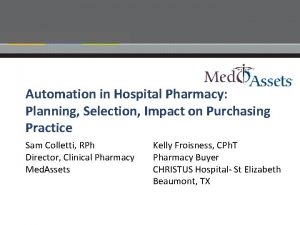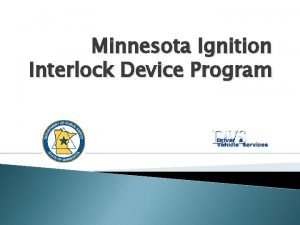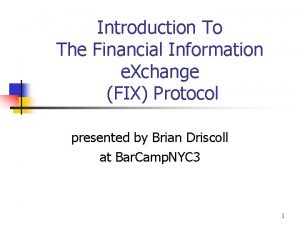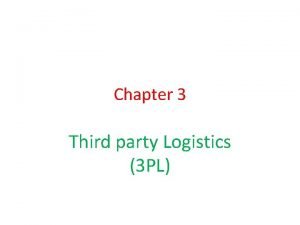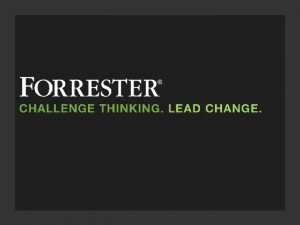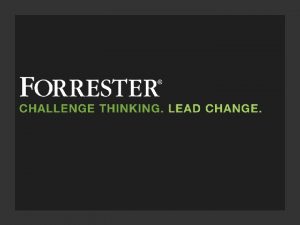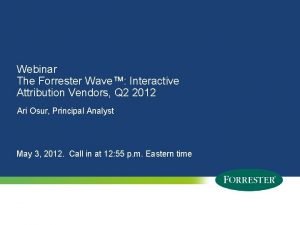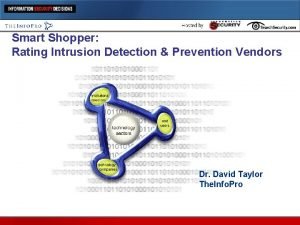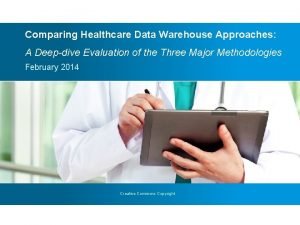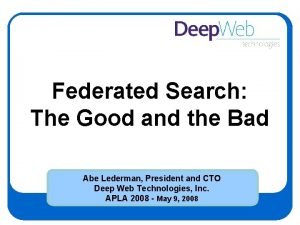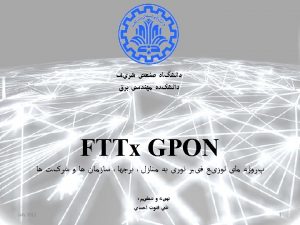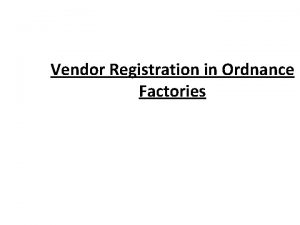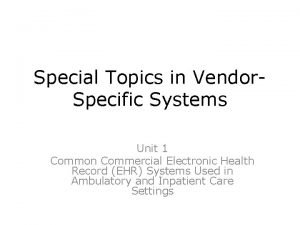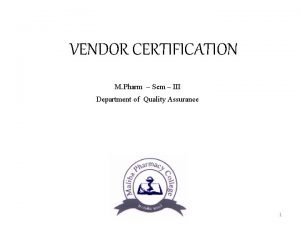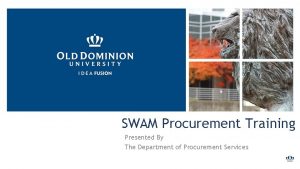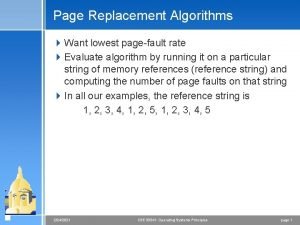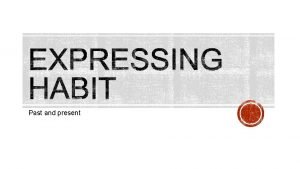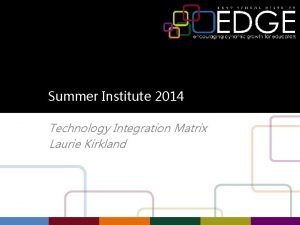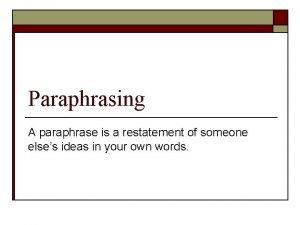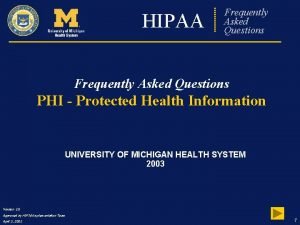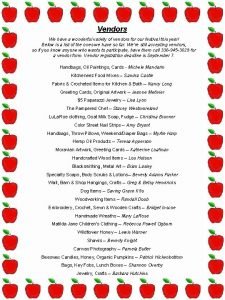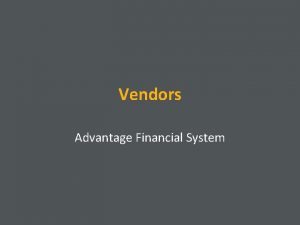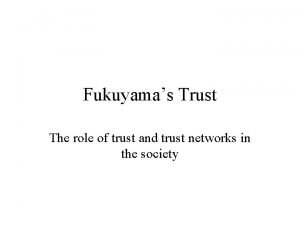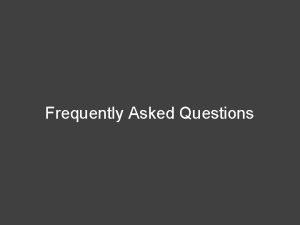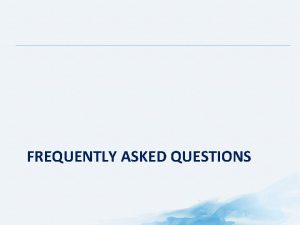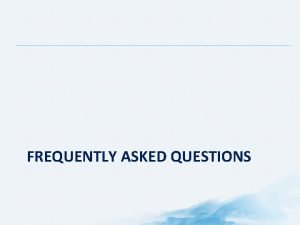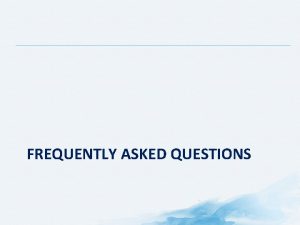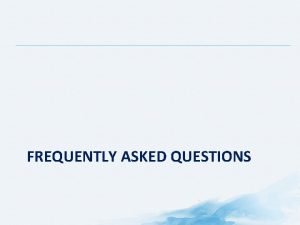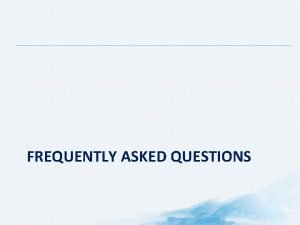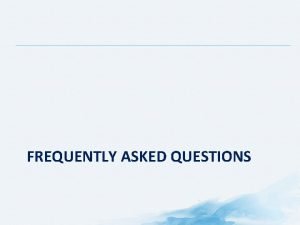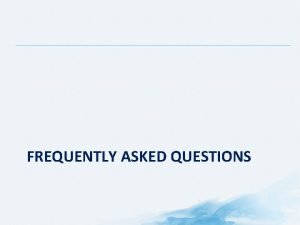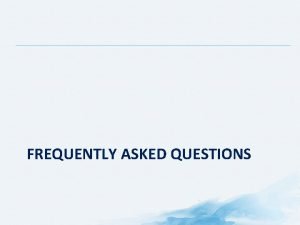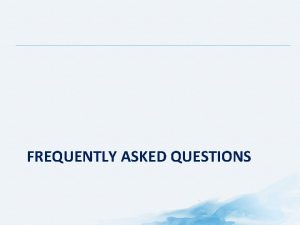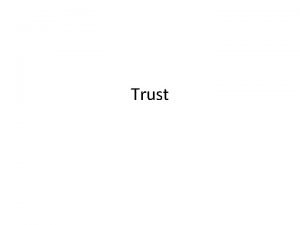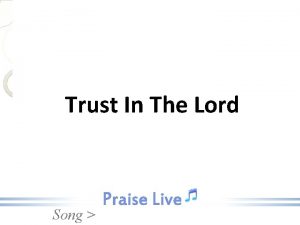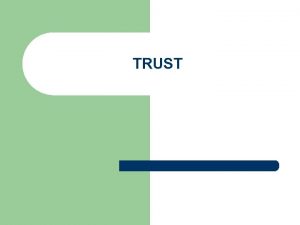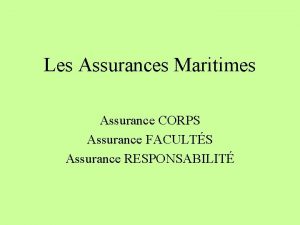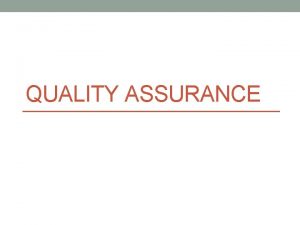Assurance Assurance And Trust Vendors frequently use the













![Building Security In or Adding Security Later… • Definition 17– 11. [25] A reference Building Security In or Adding Security Later… • Definition 17– 11. [25] A reference](https://slidetodoc.com/presentation_image/5720d930e03010198c65dfd1f33bfc42/image-14.jpg)





























![Audit browsing examples • The Visual Audit Browser tool kit [424] was designed for Audit browsing examples • The Visual Audit Browser tool kit [424] was designed for](https://slidetodoc.com/presentation_image/5720d930e03010198c65dfd1f33bfc42/image-44.jpg)
- Slides: 44

Assurance

Assurance And Trust… • Vendors frequently use the term “secure” in product names and product literature to refer to products and systems that have “some” security included in their design and implementation • Definition 17– 1. An entity is trustworthy if there is sufficient credible evidence leading one to believe that the system will meet a set of given requirements. Trust is a measure of trustworthiness, relying on the evidence provided. • Definition 17– 2. Security assurance, or simply assurance, is confidence that an entity meets its security requirements, based on specific evidence provided by the application of assurance techniques. • Assurance techniques can be categorized as informal, semiformal, or formal. • information assurance, refers to the ability to access information and preserve the quality and security of that information

… Assurance And Trust • • Definition 17– 3. A trusted system is a system that has been shown to meet welldefined requirements under an evaluation by a credible body of experts who are certified to assign trust ratings to evaluated products and systems The Trusted Computer System Evaluation Criteria and the Information Technology Security Evaluation Criteria are two standards that have been replaced by the Common Criteria.

The need for Assurance… • Applying assurance techniques is time-consuming and expensive. • 9 types of problem sources in computer systems 1. Requirements definitions, omissions, and mistakes 2. System design flaws 3. Hardware implementation flaws, such as wiring and chip flaws 4. Software implementation errors, program bugs, and compiler bugs 5. System use and operation errors and inadvertent mistakes 6. Willful system misuse 7. Hardware, communication, or other equipment malfunction 8. Environmental problems, natural causes, and acts of God 9. Evolution, maintenance, faulty upgrades, and decommissions Assurance addresses each of these problem sources

… The need for Assurance… • Design Assurance -> detect design flaws • Implementation assurance->hardware & software implementation • Operational assurance -> system use & operational errors

… The need for Assurance • The space shuttle Challenger exploded on January 28, 1986, killing everyone on board – Several sensors were removed from the booster rockets • Three patients died from a radiation overdose attributed to a Therac 25 computer-based electron accelerator radiation therapy system – Flaws in the software design • Although the most significant root cause of the Three Mile Island nuclear failure was a hardware problem (nonstandard instruments were used to measure core temperature), design and software problems contributed significantly. – When the temperature rose very high, the system printed a string of question marks rather than the measured temperature. In addition, the intended, rather than the actual, valve settings were displayed. Assurance techniques would have detected these software flaws.

The Role of Requirements in Assurance • Definition 17– 4. A requirement is a statement of goals that must be satisfied. – Generic, high level, detailed • Selecting the right security requirements for a computer entity requires an understanding of the intended use of that entity as well as of the environment in which it must function • Security models and physical laws – Some proofs have survived this test of time, and others have not.

Assurance Throughout the Life Cycle… • Definition 17– 5. Policy assurance is the evidence establishing that the set of security requirements in the policy is complete, consistent, and technically sound. – Based on rigorous evaluation of requirements • Once the proper requirements have been defined, justified, and approved for the system, the design and development process can begin with confidence. • The next step is to show that the system implements the design correctly. • Assurance must continue throughout the life of the system • Definition 17– 6. Design assurance is the evidence establishing that a design is sufficient to meet the requirements of the security policy.

…Assurance Throughout the Life Cycle • Definition 17– 7. Implementation assurance is the evidence establishing that the implementation is consistent with the security requirements of the security policy. – good security engineering practices to implement the design correctly • Definition 17– 8. Operational or administrative assurance is the evidence establishing that the system sustains the security policy requirements during installation, configuration, and day-to-day operation.

Life Cycle… • The concept of a life cycle addresses security-relevant decisions that often are made outside the engineering disciplines in business situations. • A life cycle starts when a system is considered for development and use. The life cycle ends when the system is no longer used. • Conception – It starts with an idea • Fund the idea • Reject the idea • Ask for further information – Definition 17– 9. A proof of concept is a demonstration that an idea has merit. • Tipically involves small projects • Must provide sufficient information for begin next tasks • determine threats that are visible at the conception stage

…Life Cycle… • Manufacture – For most disciplines, the manufacturing stage is the longest. – Marketing, sales, development, test plans – The actual work required by each discipline depends on the nature of the system – The output of this stage from each discipline should be the materials necessary to determine whether to proceed

…Life Cycle… • Deployment – Once the system has passed the acceptance criteria in the manufacturing stage, it is ready for deployment. – Production, distribution, shipping – Users of the system may require specific types of documentation. – Security and assurance issues in this part of deployment include knowing that was received is actually what was shipped. – Proper installation and configuration

…Life Cycle • Fielded Product Life • The primary tasks of fielded product life are patching or fixing of bugs, maintenance, and customer service • Maintenance and patching may be done by a separate organization • Commercial systems often have separate customer service and support organizations and engineering organizations. • The support organization tasks could • include answering questions, recording bugs, and solving routine customer problems.
![Building Security In or Adding Security Later Definition 17 11 25 A reference Building Security In or Adding Security Later… • Definition 17– 11. [25] A reference](https://slidetodoc.com/presentation_image/5720d930e03010198c65dfd1f33bfc42/image-14.jpg)
Building Security In or Adding Security Later… • Definition 17– 11. [25] A reference monitor is an access control concept of an abstract machine that mediates all accesses to objects by subjects. • Definition 17– 12. [25] A reference validation mechanism (RVM) is an implementation of the reference monitor concept. An RVM must be tamperproof, must always be invoked (and can never be bypassed), and must be small enough to be subject to analysis and testing, the completeness of which can be assured. • Definition 17– 13. [25] A security kernel is a combination of hardware and software that implements a reference monitor. • Definition 17– 14. [257] A trusted computing base (TCB) consists of all protection mechanisms within a computer system—including hardware, firmware, and software—that are responsible for enforcing a security policy.

…Building Security In or Adding Security Later • trade-offs may occur between features and simplicity. • Inclusion of many features often leads to complexity • Systems in which security mechanisms are added to a previous product are not as amenable to extensive analysis as those that are specifically built for security. • Testing of conformance to a flawed design is similar to designing a system to meet inappropriate requirements. • Building a system with security as a significant goal may provide the best opportunity to create a truly secure system.

• • Although it is no longer in use, many security experts consider Multics to be the best example of an operating system built for security. Firewalls are a form of guards, although they are usually single-purpose applications built on security-hardened versions of existing operating systems rather than systems developed specifically for high assurance In the late 1980 s and early 1990 s, AT&T undertook two projects to provide secure versions of UNIX System V that supported mandatory access controls. The chosen approach was to add security functionality to AT&T UNIX System V Release 3. 2. The second project was focused on restructuring and re-creating a UNIX system to provide a medium-to-high level of trust. This version, called SVR 4. 1 ES The SVR 4. 1 ES project involved extensive restructuring of the UNIX kernel to meet high-modularity requirements and to incorporate an implementation of the principle of least privilege that was integral to the UNIX kernel… …. CONTINUA CON L’ESEMPIO…

AUDITING

• Definition 21– 1. Logging is the recording of events or statistics to provide information about system use and performance. • Definition 21– 2. Auditing is the analysis of log records to present information about the system in a clear and understandable manner. • LOGS analytics • Problems – which information to log and – Which information to audit.

Anatomy of an Auditing System • Logger • The type and quantity of information are dictated by system or program configuration parameters. • Binary or human readable • Microsoft’s Windows NT has three different sets of logs. – System events – Application events – Security events

analyzer • Analyzer – An analyzer takes a log as input and analyzes it. The results of the analysis may lead to changes in the data being recorded, to detection of some event or problem, or both. • Notifier – The analyzer passes the results of the analysis to the notifier. The notifier informs the analyst, and other entities, of the results of the audit.

Designing an Auditing System • A single, well-unified logging process is an essential component of computer security mechanisms • The goals of the auditing process determine what information is logged • Represent constraints as “action ⇒ condition. ” • the goal of the auditing is to determine if the policy has been violated • Bell-La-Padula 1. 2. S reads O ⇒ L(S) ≥ L(O) S writes O ⇒ L(S) ≤ L(O) the names of the subject and object need not be recorded • auditing of reads and writes in a Bell-La. Padula-based systems requires logging the subject’s security level, the object’s security level, and the result of the action

Implementation considerations • analyzing the specific rules and axioms of a model reveal specific requirements for logging enough information to detect security violations. • one need not assume that the system begins in a secure (or valid) state because all the models assert that the rules above are necessary but not sufficient for secure operation and auditing tests necessity • Naming also affects the implementation of logging criteria (multiple names)

Syntactic Issues • What data to log, how should be expressed. • UNIX system logs the names of files that a user retrieves using ftp. • The log contains the file name /etc/passwd. If the associated user is the anonymous user (indicating an anonymous login), then the file actually retrieved is the password file in the anonymous ftp subtree, not the system’s password file. • a single log entry may not contain all the information about a particular action • Flack and Atallah suggest using a grammar-based (BNF) approach to specifying log content.

Log Sanitization • Definition 21– 3. Let U be a set of users. The policy P defines a set of information C(U) that members of U are not allowed to see. Then the log L is sanitized with respect to P and U when all instances of information in C(U) are deleted from L. • Confidentiality policies may impact logs in two distinct ways. 1. 2. P may forbid the information to leave the site P may forbid the information to leave the system

• Definition 21– 4. An anonymizing sanitizer deletes information in such a way that it cannot be reconstructed by either the recipient or the originator of the data in the log. A pseudonymizing sanitizer deletes information in such a way that the originator of the log can reconstruct the deleted information. • Biskup and Flegel point out that one need not sanitize data that is not collected-> do not collect data. Otherwise: – The first step is to determine a set of pseudonyms – Some set of individuals are able to see unsanitized data

Applications and System Logging… • Application logs consist of entries made by applications. These entries typically use high-level abstractions, such as su: bishop to root on /dev/ttyp 0 smtp: delivery failed; could not connect to abcxy. net: 25

… Applications and System Logging • The difference in the two logs is their focus • On application events ->application log • On system events -> system logging • The advantage of system logs is the completeness of the information recorded -> large files difficult to read • The advantage of application logs is the level of abstraction • The correlation problem relates system & application logs.

A Posteriori Design • The design of an effective auditing subsystem is straightforward when one is aware of all possible policy violations and can detect them. • Most security breaches arise on existing systems that were not designed with security considerations in mind. • In this case, auditing may have two different goals. – The first goal is to detect any violations of a stated policy; – the second is to detect actions that are known to be part of an attempt to breach security.

Auditing to Detect Violations of a Known Policy • The idea is to determine whether or not a state violates the policy • State-Based Auditing • Definition 21– 5. A state-based logging mechanism records information about a system’s state. A state-based auditing mechanism determines whether or not a state of the system is unauthorized. – There is a tacit assumption that a state-based logging mechanism can take a snapshot of the system. – Obtain a consistent state • Transition-Based Auditing • Definition 21– 6. A transition-based logging mechanism records information about an action on a system. A transition-based auditing mechanism examines the current state of the system and the proposed transition (command) to determine if the result will place the system in an unauthorized state. – may not be sufficient to enable a transition-based auditing mechanism to determine if the system will enter an unauthorized state

Auditing to Detect Known Violations of a Policy • In many cases, the security policy is not stated explicitly, but many behaviors are considered “nonsecure”. • Daniels and Spafford present an analysis of the Land attack, which causes a denial of service by causing the target of the attack to hang or to respond very slowly. • Detecting this attack requires that the initial Land packet be detected. The characteristic of this packet is that the source and destination addresses and port numbers are the same. So, the logging requirement is to record that information. The audit requirement is to report any packets for which the following condition holds.

Auditing Mechanisms Different systems approach logging in different ways Secure Systems Auditing mechanisms integrated within the system The VAX VMM system is designed to meet the requirements of the A 1 classification of the TCSEC • The system is designed as a layered kernel, and so the logging mechanisms are not unified. Logging occurs at each place in the hierarchy where events of interest occur. Each layer also audits accesses to the objects it controls. In essence, the auditing mechanisms are distributed throughout the layers. • Two types of events are always logged. • • – The first results from the caller’s setting a special flag and is under the programmers’ control. – The second is an attempt to violate policy and is required by the criteria used to certify systems. Protection violations and login failures are recorded when the event occurs repeatedly. Use of covert channels is also flagged.

Nonsecure Systems • Auditing subsystems for systems not designed with security in mind are generally for purposes of accounting. • The Basic Security Module (BSM) [887] is an enhancement of Sun. OS system security. • Each log consists of files, and each file is composed of individual records. • A record is made up of a sequence of tokens. The record size is not fixed; there is a begin token and an end token. Each record refers to an auditable event. • The information is stored in a binary format to minimize log size. A program called praudit formats and prints records when a humanreadable form is needed. • The determination of what to log and what to audit is left to the system managers.

Auditing File Systems • one computer (called a client host) requests access to the file system of another computer (a server host). The server host responds by exporting a directory of its file system; the client host imports this information and arranges its own file system so that the imported directory (called the server host’s mount point) appears as a directory in the client host’s file system (this directory is called the client host’s mount point). • Audit Analysis of the NFS Version 2 Protocol – A site connected to the Internet – Runs a LAN with UNIX Systems using Network File System. What to log? – NFS is a stateless protocol – All imported file systems are – supposed to be as secure as the local file systems.

Audit Analysis of the NFS Version 2 Protocol • The policies: 1) 2) 3) NFS servers will respond only to authorized clients. The UNIX access controls regulate access to the server’s exported file system. No client host can access a nonexported file system. • The constraints 1. 2. 3. 4. File access granted ⇒ client is authorized to import file system, user can search all parent directories and can access file as requested, and file is descendant of server host’s file system mount point. Device file created or file type changed to device ⇒ user has UID of 0. Possession of a file handle ⇒ file handle issued to that user. Operation succeeds ⇒ a similar operation local to the client would succeed.

Audit Analysis of the NFS Version 2 Protocol • Those operations that take file handles as arguments require that the auditor validate the constraint. When a server issues a file handle, the user to whom it is issued, and the client to which it is sent must be recorded.

NFS operations

Audit Analysis of the NFS Version 2 Protocol L 1. When a file handle is issued, the server must record the file handle, the user (UID and GID) to whom it is issued, and the client host making the request. L 2. When a file handle is supplied as an argument, the server must record the file handle and the user (UID and GID). L 4. Record the results of each operation. L 5. Record the name of the file argument in the LOOKUP operation.

Audit Analysis of the NFS Version 2 Protocol • Constraints C 1 and C 4 define the audit criteria for MOUNT. A 1. Check that the MOUNT server denies all requests by unauthorized client hosts or users to import a file system that the server host exports. • This means that the MOUNT server must record L 3 and L 4. • Constraints C 1 and C 3 give the audit criteria for LOOKUP. A 2. Check that the file handle comes from a client host and a user to which it was issued. A 3. Check that the directory has the file system mount point as an ancestor and that the user has search permission on the directory.

The Logging and Auditing File System (LAFS) • LAFS is a file system that records user level actions taken on files. • A policy language allows an auditor to automate checks for violations of policy. • The LAFS file system is implemented as an extension of an existing file system, NFS.

The Logging and Auditing File System (LAFS) • LAFS components: – Configuration assistant, sets up the protection modes – Audit logger, logs accesses to files – Policy Checker, validates policy • A goal of LAFS is to avoid modifying applications to enable the logging. • The file src. c is a regular file. The file src. c%log contains a log of all accesses to src. c. • The file src. c%policy contains a description of the access control policy for the file src. c. • Accessing the virtual file src. c%audit triggers an audit in which the accesses of src. c are compared with the policy for the file. • Any accesses not conforming to the policy are listed.

The Logging and Auditing File System (LAFS)

Comparison • Similarities: – A security policy controls access – The goal is to detect and report attempted violations of the policy – Have auditing mechanisms built in • Differences: – LAFS is “stacked” on top of NFS – an attacker could avoid being audited only by not using NFS. • LAFS allows users to specify policies for sets of files and to perform audits. The analysis of NFS above is not as flexible. • The user defines the policies, not the user • the NFS auditing mechanism will examine all file accesses, whereas LAFS may not. • modifying NFS for auditing requires changes in several privileged daemons, whereas adding LAFS requires no modifications to existing system daemons and a kernel.

Audit Browsing • auditors sometimes look through the log files themselves. – – Missing information Irregularities Unknown patterns Etereogenity • Hoagland, Wee, and Levitt identify six basic browsing techniques: – – – Text display Hypertext display Relational database browsing Replay Graphing Slicing
![Audit browsing examples The Visual Audit Browser tool kit 424 was designed for Audit browsing examples • The Visual Audit Browser tool kit [424] was designed for](https://slidetodoc.com/presentation_image/5720d930e03010198c65dfd1f33bfc42/image-44.jpg)
Audit browsing examples • The Visual Audit Browser tool kit [424] was designed for generalpurpose audit browsing: – – The frame visualizer The movie maker Hypertext generator Focused audit browser • Mie. Log [892] computes counts of single words and word pairs in logs. It allows the auditor to define a threshold count – – The tag appearance frequency area The time information area The outline of message area the message in text area
 Northern trust charitable trust
Northern trust charitable trust Pharmacy carousel vendors
Pharmacy carousel vendors Street art vendors nyc
Street art vendors nyc Mn ignition interlock
Mn ignition interlock Fix engine vendors
Fix engine vendors 3pi logistics
3pi logistics Forrester wave predictive analytics 2016
Forrester wave predictive analytics 2016 Real time interaction management
Real time interaction management Data fabric vendors
Data fabric vendors Forrester wave predictive analytics 2016
Forrester wave predictive analytics 2016 Forrester wave cross channel attribution
Forrester wave cross channel attribution Ids ips vendors
Ids ips vendors Ibm n series
Ibm n series Healthcare data warehouse schema
Healthcare data warehouse schema Benefits of federated search
Benefits of federated search Gpon vendors
Gpon vendors Nwdaf vendors
Nwdaf vendors Ordnance factory vendor registration
Ordnance factory vendor registration Efs supplier portal
Efs supplier portal Top 10 ambulatory ehr vendors
Top 10 ambulatory ehr vendors Sem vendors
Sem vendors Swam vendors
Swam vendors Stars ii vendors
Stars ii vendors Answer to how often
Answer to how often Lru algorithm calculator
Lru algorithm calculator An action that was frequently repeated in the past
An action that was frequently repeated in the past Always usually often sometimes
Always usually often sometimes Tolerates no challenge to his authority
Tolerates no challenge to his authority Www.kent.k12.wa.us frequently used links
Www.kent.k12.wa.us frequently used links Restate and paraphrase
Restate and paraphrase Hipaa frequently asked questions
Hipaa frequently asked questions Hình ảnh bộ gõ cơ thể búng tay
Hình ảnh bộ gõ cơ thể búng tay Bổ thể
Bổ thể Tỉ lệ cơ thể trẻ em
Tỉ lệ cơ thể trẻ em Gấu đi như thế nào
Gấu đi như thế nào Glasgow thang điểm
Glasgow thang điểm Hát lên người ơi
Hát lên người ơi Môn thể thao bắt đầu bằng từ đua
Môn thể thao bắt đầu bằng từ đua Thế nào là hệ số cao nhất
Thế nào là hệ số cao nhất Các châu lục và đại dương trên thế giới
Các châu lục và đại dương trên thế giới Công thức tính độ biến thiên đông lượng
Công thức tính độ biến thiên đông lượng Trời xanh đây là của chúng ta thể thơ
Trời xanh đây là của chúng ta thể thơ Cách giải mật thư tọa độ
Cách giải mật thư tọa độ 101012 bằng
101012 bằng

